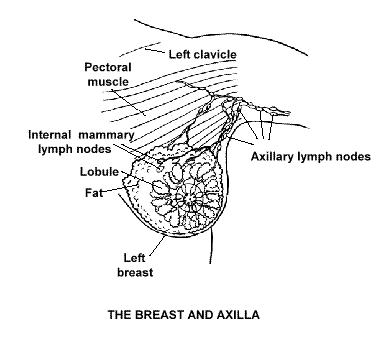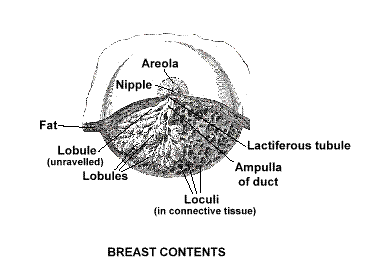

This is a review of some of the basic facts that are related to breast cancer. It compliments our Comprehensive Report on Breast Cancer which focuses mainly on state-of-the-art treatment protocols, experimental clinical trials that are open, and current research. For details on that report, see the link. If you care to print this file, it is about 9 pages.
Breast cancer is a disease in which transformed cells (neoplasms) arise in the tissues of the breast. Breast cancer is described as being "ductal" or "lobular", depending on the site of origin, with the former being the most common kind. An uncommon type is "inflammatory" breast cancer. Breast cancer occurs most frequently in females; however, a small percentage of males do get the disease. In the U.S., in females, there were about 184,000 new cases of breast cancer diagnosed in the year 2000, and there was a total of about 2,181,000 standing cases. (For males, the figures were 1,400 new cases and 14,000 total.) The life-time risk of a female being diagnosed with breast cancer is about 14.85%, and the life-time risk of dying from breast cancer is 3.34%. Approximately 5% to 10% of all breast cancer cases are considered hereditary.
There are seven diagnostic stages of breast cancer: Stages 0, I, II, III, & IV, inflammator, and recurrent.
Stage 0. Ductal carcinoma in situ (DCIS; also known as intraductal carcinoma) is a very early breast cancer that may develop into an invasive (cancer that has spread from the duct into surrounding tissues) type of breast cancer. Lobular carcinoma in situ (LCIS) is not cancer, but rather a marker that identifies a woman at increased risk to develop invasive (cancer that has spread into surrounding tissues) breast cancer later in life.
Stage I. The cancer is no larger than 2 centimeters (about 1 inch) and has not spread outside the breast.
Stage II. Stage II is divided into stages IIA and IIB.
Stage IIA is defined by either of the following:
The cancer is no larger than 2 centimeters but has spread to the lymph
nodes under the arm (the axillary lymph nodes).The cancer is between 2 and 5 centimeters (from 1 to 2 inches), but
has not spread to the lymph nodes under the arm.Stage IIB is defined by either of the following:
The cancer is between 2 and 5 centimeters (from 1 to 2 inches), and
has spread to the lymph nodes under the arm.The cancer is larger than 5 centimeters (larger than 2 inches), but
has not spread to the lymph nodes under the arm.Stage III. Stage III is divided into stages IIIA and IIIB.
Stage IIIA is defined by either of the following:
The cancer is smaller than 5 centimeters and has spread to the lymph
nodes under the arm, and the lymph nodes are attached to each other or
to other structures.The cancer is larger than 5 centimeters and has spread to the lymph
nodes under the arm.Stage IIIB is defined by either of the following:
The cancer has spread to tissues near the breast (skin or chest wall,
including the ribs and the muscles in the chest).The cancer has spread to lymph nodes inside the chest wall along the
breast bone.Stage IV. The cancer has spread to other organs of the body, most often the bones, lungs, liver, or brain. Or, tumor has spread locally to the skin and lymph nodes inside the neck, near the collarbone.
Inflammatory breast cancer. Inflammatory breast cancer is a special class of breast cancer that is rare. The breast looks as if it is inflamed because of its red appearance and warmth.
Recurrent. Recurrent disease means that the cancer has come back (recurred) after it has been treated. It may come back in the breast, in the soft tissues of the chest (the chest wall), or in another part of the body.
The conventional treatments are: surgery, radiation, chemotherapy, and hormone therapy. Biological therapy (using the body's immune system to fight cancer), bone marrow transplantation, and peripheral blood stem cell transplantation are being tested in clinical trials. As of January 2002, there were over 200 active, experimental, clinical trials that are being conducted, and during 2001 there were about 6,500 research reports which were published on breast cancer, both of which indicate a high degree of research activity.
In our Comprehensive Report on Breast Cancer, we detail the various stages and therapeutic alternatives. The experimental trials are listed and the most recent research citations are provided. The report is a component of what we call The Life-extension Approach to Medicine.
Below is some graphic information that is relevant to breast cancer. (The data are taken from The Surveillance, Epidemiology, and End Results (SEER) Program of the National Cancer Institute.)
Anatomical sites that are associated with breast cancer are below.   |
Total Incidence of Breast Cancer. Incidence means the number of cases of the disease per year per 100,000 population (U.S.). It provides an idea about the magnitude of the disease, whether some change in condition is causing an increase or decrease, and whether preventive measures are being effective.
Comments. The total incidence in breast cancer has increased over the last three decades. In the age category over 50, in 1973 the incidence was 248 per 100,000 and in 1998 it was 381 per 100,000. That is an increase of 53%. In the age category under 50, it was 29 and 33, respectively. Some of this increase is probably due to breast cancer screening programs that identify tumors which otherwise would have gone unrecorded. Also, the increase in smoking by women, which began in the 1960's, is now becoming manifest in cancers related to that. The figures are supposed to be adjusted for age to a 1970 reference population, thus the increase should not be due to the shift toward an older population.
Incidence of Breast Cancer by Age Category. This analyzes the incidence by specific age groups per 100,000 population.
Comments. There is a strong correlation between breast cancer and biological ageing, suggesting that a systemic deterioration, perhaps in the immune system or neuro-endocrine regulation or extra-cellular matrix, might be a primary, causative agent. Breast cancer will not be preventable unless and until biological ageing is cured.
Death or Mortality Rates of Breast Cancer. This is a measure of the number of persons dying from the disease per 100,000 population per year. It provides an idea about whether medical therapies are being effective.
Comments. The death rate from breast cancer in those under age 50 is relatively low and has declined slightly over the last 30 years. In the age category over 50, in 1973 the incidence was 88 per 100,000 and in 1998 it was 78 per 100,000. That represents a decline of 11%. The improvement is probably due mostly to a healthier population that survives longer rather than improved medical treatments.
Mortality or Death of Breast Cancer by Age Category. This breaks out the total mortality above by specific age groups within a given age cohort as an average for a period of 4 years.
Comments. Again, there is a strong correlation between death from breast cancer and biological ageing, suggesting that a systemic deterioration, perhaps in the immune system or neuro-endocrine regulation or something more fundamental such as exta-cellular matrix deterioration, might be a primary, causative agent.
Survival Rates of Breast Cancer. These data show, at different epochs, the percentage of persons surviving the disease over a 5 year period.
Comments. In 1975, of those who were diagnosed with breast cancer, 94% were still alive after year 1 and 75% were alive at year 5. In 1993, the percentages improved slightly to 97% and 86% respectively. This improvement in survival is due mostly to a healthier population rather than medical treatments.
The Status of Research. One measure of potential progress on a particular disease is the amount of research which is being done. In the MEDLINE database, the number of reports on breast cancer has steadily increase.
Also, the main funding agency for cancer in the U.S. has steadily increased its budget to about $3.25 billion annually; and a fair portion of that goes toward breast cancer.
Comments. Research on breast cancer receives a huge amount of funding; and the number of research reports on breast cancer continues to accelerate. In spite of that, little progress has been realized in prevention and cure. In our Comprehensive Report on Breast Cancer, we enable people to become directly involved in moving this science forward.
Return to Home Page